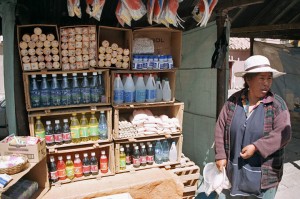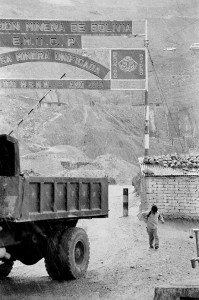At the miner’s market, one can buy bottles of soda, thick cigarettes, tubes of crackers, 200-proof alcohol and dynamite, all from the same vendor. When tourists are led up to these stands, the Señora in charge happily assembles little packages of explosives, smokes, and bottles and helpfully recommends a coca leaf seller to complete the gift. Then, clutching their packages, the tourists are driven up the mountain in small vans that shake incessantly on the unpaved road.
The tourist industry in Potosi, Bolivia is showy and honest and absurd. The city is home to what used to be the biggest silver mine in the world, Cerro Rico. At its peak, throughout the 1600s, it was the biggest, the richest, the most culturally opulent, and one of the most populous metropolises in the world. Since then, declining at time rapidly, at times less obviously, due to the waning of quality silver ore, the city has degenerated into one of the poorest regions in the second poorest nation in the entire Western hemisphere. Long dependent on what came out of the mines, Potosi is now trying to help make ends meet by bringing something into the mine: foreigners.
The tours cost about $10-$20 and are usually led by ex-miners who’ve managed to get out of the mine, a fate often envied and revered by the brothers, friends, and father that stay behind. You’ll get a hard hat and lamp along with rubber boots and rain suit and the guide will lead you into a dusty, hellishly warm and narrow mine shaft. Many guides set off explosives with their groups on the mountainside before going into the mine – tends to be a crowd-pleaser for visitors from countries where explosives are less readily available. Inside, groups pay homage to the shaft’s anti-saint, a devil figure who must be appeased with words, cigarettes, booze, and coca in order for good ore to be released by the mountain. Then, they make their way around the shafts of the mine observing miners at work and talking to them. The baggies of goods from the market are gifted to miners.
It’s totally chaotic because the mountain is unregulated, explosions are unannounced and uncalculated in any comprehensive way, children and men push heavy loads of mineral along crooked tracks in trolleys without breaks, there is little infrastructure and the mines are not designed to house the workers and their operations, not to mention tourists. But, for the curious and un-claustrophobic, it’s a very unfettered view of how the mountain and its eternal toilers live on after almost 500 years. What one learns is that conditions have not changed much since the days of [supposed] yore. Conditions are horrible, child labor rampant, wages bad, health problems inevitable, tools primitive. It’s extraordinarily difficult work with limited alternatives for mining families.
I recommend finding a company with good safety and ethics records before booking a tour. Tours may be slightly more expensive, but several important things are at stake here: your safety, the guide’s knowledge of and responsibility to the shaft he takes the group to, quality of the gear (lamps, boots, etc) you get, quality of English (or other desired language) spoken by the guide, and the time the guide actually spends explaining what you’re seeing. Since everything is so unregulated, anyone can start an operation but it’s a lot better to hear this story from someone who knows it as well as someone who’s invested in it. I’ve gone twice, both with Marco Polo Tours’ (Bustillos 1036, marcopoloagency@hotmail.com) Wilfredo Bracamonte and can’t recommend his tour highly enough. Also, consider skipping the mountainside fireworks display and gift the explosives to the miners, instead.
- Get a universal plug adapter
- Search for Great Tours HERE
- Buy Travel Insurance
- Get an eSim to be able to use your smartphone abroad.
- Get a Car Rental
- Book Your Accommodation HERE



 Travel to Bolivia – Episode 313
Travel to Bolivia – Episode 313

Arlo
Says:October 24th, 2011 at 4:56 am
When my wife and I were in Potosí, it happened to be the one day of the year when every miner takes off work and celebrates in the mining festival instead. We did get to do the mine tour, but without any activity at all inside the twisting warrens.
There was, of course, no one to accept our dynamite gifts, so we blew it up on the mountainside, instead:
http://youtu.be/1sASn302ocU?hd=1
Crazy place.